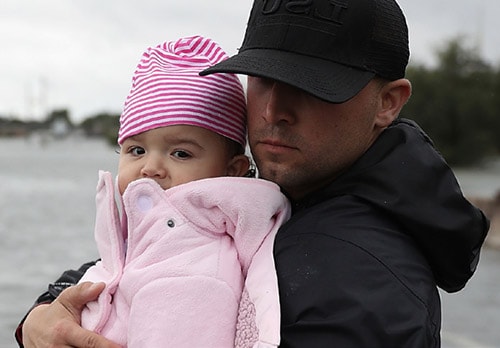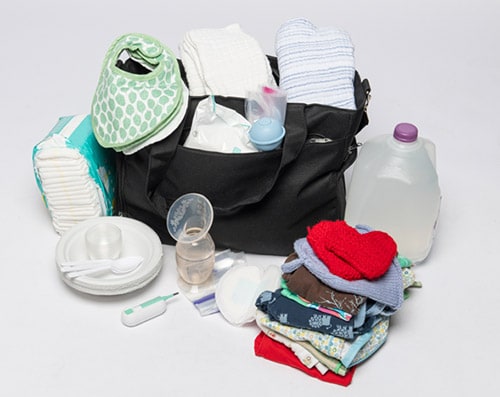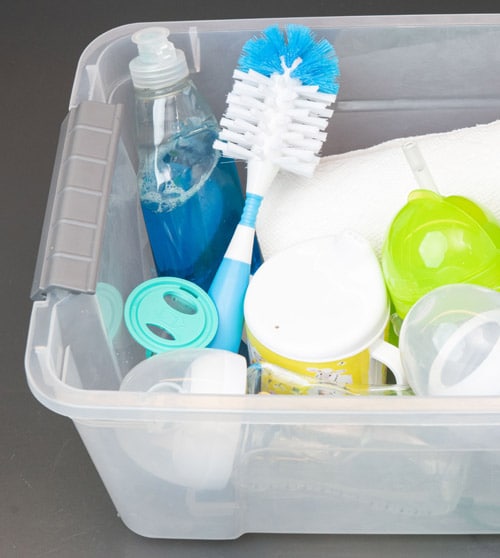Preparedness
In the event of a natural disaster or other emergency, be prepared for challenges that can impact infant and young child feeding, which may include power outages, unhealthy living spaces, unsafe water, disrupted access to supplies, and stressful situations.
Training and Education
Training for emergency relief workers is important to understand how to appropriately support the needs of infants and young children during an emergency. Relief workers can be prepared in the following ways:

- Learn about breastfeeding before an emergency occurs.
- Gather surveillance data about breastfeeding rates in the state or community. Breastfeeding initiation, exclusivity, and duration rates can be used to plan for services and supplies that will be needed.
- Learn about safe storage of premixed, or ready-to-feed (RTF), infant formula.
- Learn about safer preparation of powdered infant formula and how to ensure safe infant formula feeding during emergencies.
- Learn about complementary feeding for 6 to 24 month old children.
- Learn about how to safely store and clean infant feeding items such as bottles, and breast pumps.
- Learn about cup feeding, an alternative way to feed infants when they are unable to feed directly at the breast and when infant feeding items cannot be cleaned properly.
- Learn about hand expression, a technique used to release milk from the breast by hand, without using a breast pump.
- Learn about how to take action to support and promote breastfeeding.
- Consider training to become a lactation support provider.
- Learn about creating safe family-friendly spaces in shelters and supporting infant and young child feeding in shelters.

Teaching families how to be prepared is one of the best ways to make sure that infants and young children will be safely and appropriately fed during and after an emergency. Learn more about what steps expecting and new parents can take to prepare for an emergency.
Making Connections
- Work with local health care providers and lactation support providers to teach families how to create an individual preparedness plan and what to include in an emergency kit.
- Know about the different types of lactation support providers [PDF-188KB] and how to connect with lactation support providers in your community.
- Build partnerships with community-based lactation-related services, such as:
- State, local, tribal, and cultural breastfeeding coalitions
- The Special Supplemental Nutrition Program for Women, Infants, and Children (WIC) clinics
- Baby Cafes
- Hospital-based lactation programs
- La Leche League
- Breastfeeding USA (Locate local support, warmline available 612-293-6622)
- Reaching Our Sisters Everywhere (ROSE)
- Human milk banks
- Breastfeeding support services might also be integrated into public health programs such as Healthy Start, Early Head Start, Nurse Family Partnership, Federally Qualified Health Centers, hospital outpatient clinics, and the Maternal, Infant, and Early Childhood Home Visiting program (MIECHV)
- Become familiar with lactation support services such as the National Women’s Health and Breastfeeding Helpline, which is available Monday through Friday 9am-6pm ET at 1-800-994-9662.
- Connect with federal, state, tribal, and local emergency relief organizations to plan and coordinate a process for acquiring infant feeding supplies.
- Build partnerships with local organizations that provide social services (e.g., WIC, Supplemental Nutrition Assistance Program, faith-based organizations, community centers).
Creating a Plan

- Ensure infant and young child feeding support, such as safe cleaning of infant feeding items and lactation support, is included in your community’s disaster preparedness plans.
- Develop and conduct tabletop exercises that incorporate infant and young child feeding considerations. Engage the community in planning and practicing these exercises. This will increase awareness about IYCF-E, identify gaps in preparedness activities, and strengthen partnerships.
- Review training resources specific to children in disasters.
- Identify post-disaster epidemiologic indicators [PDF-815KB] for pregnant and postpartum women and their infants to assist in identifying post-disaster needs for your state or locality. This document describes the process for developing the post-disaster indicators.
- When selecting shelter locations, be sure that they have adequate washing stations for cleaning infant feeding items separately from diapering stations. Infant feeding items should not be washed in restrooms.
- Ensure all preparedness plans include a plan for when there is no safe water.
- Create a plan to provide families with timely direct assistance to address infant feeding challenges during emergencies. This can be done by:
- Setting up an onsite lactation support clinic
- Identifying alternative options, such as telehealth or on-site visits from local lactation support providers or home visiting nurses who support breastfeeding families
- Build partnerships with human milk banks (even if they are in a different state) to develop a process to acquire donor human milk for families in need during emergencies.
- Develop written guidelines that address obtaining infant formula and safe storage, handling, and distribution of infant formula [PDF-360KB], including the following:
- Infant formula supply
- For infants already being fed formula, ready-to-feed (RTF) infant formula is the safest option during an emergency (it does not need to be mixed with water and it is available in sterile individual single-use containers).
- How to safely store and use powdered infant formula when RTF is not available.
- Storage locations and temperatures
- Extreme heat can affect the safety of RTF infant formula.
- Keep all infant formula and related supplies out of view of people staying in the shelter to avoid unintentional promotion or marketing of these products.
- Distribution to families
- Tracking expiration dates and potential recalls
- How to respond to infant formula donations
- Calculating infant formula needs in an emergency
- Providing accurate information to families on storage, handling, and preparation of powdered infant formula, as well as cleaning instructions
- Infant formula supply

Consider the needs of children transitioning to solid food in plans to obtain and provide foods at the relief shelter. Think about which tools may be needed to prepare foods appropriately (e.g., blender) for these children.
- Plan for how the shelter will accommodate children with special healthcare needs who are technology dependent and require electricity for their feeds. This may require additional resources (e.g., a back-up power source, extra batteries, coolers, ice packs).
- Create a plan for the coordination of infant feeding support for families who are in non-congregate sheltering settings (hotel, motel, dormitories, converted building space). These settings may not have adequate resources for infant feeding. Make sure these families have infant feeding supplies and that there are community referrals in place (e.g., volunteers, community health workers, first responders) for additional support. Some local community organizations can also do home visits, which may be helpful for families in non-congregate sheltering settings.
